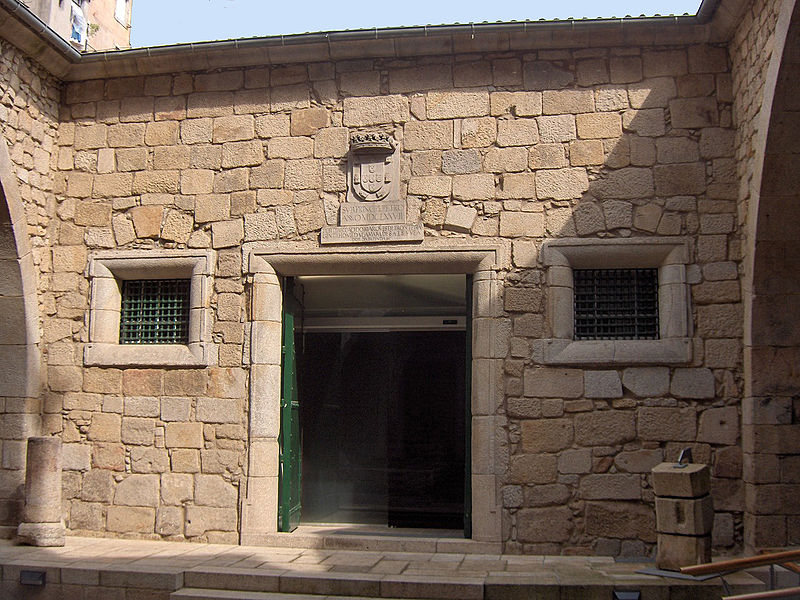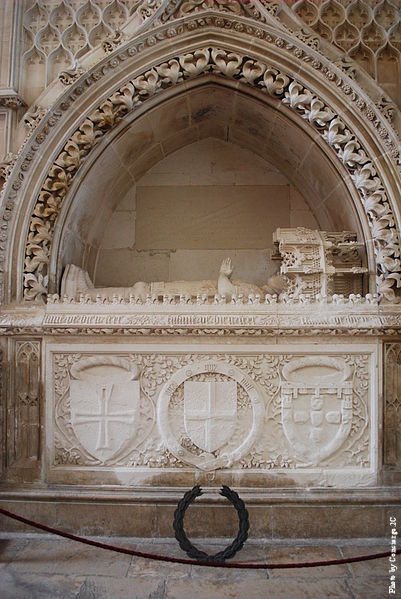Prince Henry the Navigator
Born 4 March, 1394; died 13 November, 1460; he was the fourth son of John I, King of Portugal, by Queen Philippa, a daughter of John of Gaunt.
 In 1415 he commanded the expedition which captured Ceuta, Portugal’s first oversea conquest, and there won his knightly spurs. Three years later he went to the assistance of the town, when it was besieged by a Moorish army, and twice afterwards fought in Africa. He was responsible for a disastrous attack on Tangier in 1437, which caused the captivity and death of his brother Fernando (Blessed Ferdinand), “the Constant Prince”, while at the end of his life, in 1458, he took part in the capture of Alcacer. On the death of his brother, King Duarte, Henry acted as intermediary between his brother Pedro, who claimed the regency, and Queen Leonor, to whom it had been left by her husband, and he greatly promoted the success of Pedro’s claim. But when, later on, Pedro’s vaulting ambition led him into conflict with King Affonso V, Henry was unable to save him from defeat and death at the battle of Alfarrobeira. It is not, however, as a man of war or of politics that Henry has won fame, but as the initiator of continuous maritime exploration.
In 1415 he commanded the expedition which captured Ceuta, Portugal’s first oversea conquest, and there won his knightly spurs. Three years later he went to the assistance of the town, when it was besieged by a Moorish army, and twice afterwards fought in Africa. He was responsible for a disastrous attack on Tangier in 1437, which caused the captivity and death of his brother Fernando (Blessed Ferdinand), “the Constant Prince”, while at the end of his life, in 1458, he took part in the capture of Alcacer. On the death of his brother, King Duarte, Henry acted as intermediary between his brother Pedro, who claimed the regency, and Queen Leonor, to whom it had been left by her husband, and he greatly promoted the success of Pedro’s claim. But when, later on, Pedro’s vaulting ambition led him into conflict with King Affonso V, Henry was unable to save him from defeat and death at the battle of Alfarrobeira. It is not, however, as a man of war or of politics that Henry has won fame, but as the initiator of continuous maritime exploration.
Fulfilling the mission of the Military Order of Christ, of which he was Grand Master, his ships carried on a constant war against the infidels, and in one of the voyages (1418) Zarco by chance discovered the Madeira Islands. Henry had entered on his career of discovery immediately after the fall of Ceuta, and his objects were:
- (1) to know the country beyond Cape Bojador, the furthest limit of the known world on the west side of Africa;
- (2) to open up trade relations;
- (3) to learn the extent of the Mohammedan power;
- (4) to find a Christian prince who would aid him in his crusading work (he had heard of Prester John);
- (5) to spread the Christian Faith.
To achieve these objects, his swift caravels made continual voyages down the African coast, and in 1434, after twelve years of failures, one of his seamen, Gil Eannes, bolder than the rest, and inspired by his master’s zeal and generosity, doubled the terrible Cape. From that date events move quickly, and Henry, while still bearing in mind his crusading ideal, became more and more an explorer for the sake of knowledge, though he also endeavoured to draw commercial profit from the new-found Lands which would recoup his order for the vast expense of the voyages. He showed his scientific sagacity by obtaining from some captured natives (Azenegues) sufficient information about the Senegal to enable his men to recognize it when they reached it; moreover, he not only studied the ancient geographers and medieval maps, but engaged an expert map and instrument-maker, Jayme of Majorca, so that his explorers might have the best nautical information. This last incident probably accounts for the legend of the School of Sagres, which is now discredited. Though Henry certainly spent much time in the Algarve, of which province he was governor, the centre of his maritime activity was not Sagres or the Villa do Infante, but Lagos, where nearly all the early expeditions were equipped.
In 1436 Affonso Baldaya reached the Rio do Ouro and went 300 miles beyond Bojador; in 1441 Antam Gonçalves brought back the first captives, and Nuno Tristam penetrated as far as Cape Branco, and a year later to Arguim Bay; while in 1445 Dinis Diaz discovered Cape Verde. In two subsequent voyages, Cadamosto (1455-6) and Diogo Gomes (1458-60) explored the Senegal and the Gambia, and sailed down the coast as far as Sierra Leone. But this and the finding of the Azores and Cape Verde Islands was all the result Prince Henry saw, for he died in November, 1460, deeply in debt as the price of his lifelong service to the cause of Christianity and science. The finding of the road to India by Vasco da Gama, which completed Henry’s work, and the discovery of America, to which Columbus was inspired by the achievements of Henry and his successors, led to a greater spread of the Faith than the Prince could have imagined. By his voyages he removed the imagined terrors of the deep and, in the words of Azurara, “joined East to West, that the peoples might learn to exchange their riches”. Under his ægis were established the first exploring and commercial companies of modern times, and, though he has been reproached with encouraging slavery, it must be remembered that the age saw no harm in the traffic; that the Africans who were brought to Portugal by his captains were employed in domestic offices and fairly treated, and that nearly all of them became Christians. If the men who carried on his work fell short of his high ideals, Henry at least lived up to the very letter of his device, Talant de bien faire, “the desire to do well”.
MAJOR, Life of Prince Henry of Portugal (London, 1868); ID., Discoveries of Prince Henry the Navigator (London, 1877); BEAZLEY, Prince Henry the Navigator (New York and London, 1895); AZURARA, Chronica de Guiné (Paris, 1841), and tr. by BEAZLEY AND PRESTAGE, The Chronicle of Guinea (2 vols., London, 1896-9); OLIVEIRA MARTINS, Os Filhos de D. Joäo I. (Oporto, 1891); Alguns Documentos da Torre do Tombo acerça das Navegaçãoes e Conquistas Portuguezas (Lisbon, 1892;) DE VEER. Prinz Heinrich der Seefahrer (Danzig, 1864); DE SOUSA HOLSTEIN, A Escola de Sagres (Lisbon, 1877). BOURNE, Prince Henry the Navigator in Yale Review (1894); RUGE, Prinz Heinrich der Seefahrer in Globus (1894), LXVI; MEES, Henri le Navigateur (Brussels, 1901).
EDGAR PRESTAGE (Catholic Encyclopedia)











